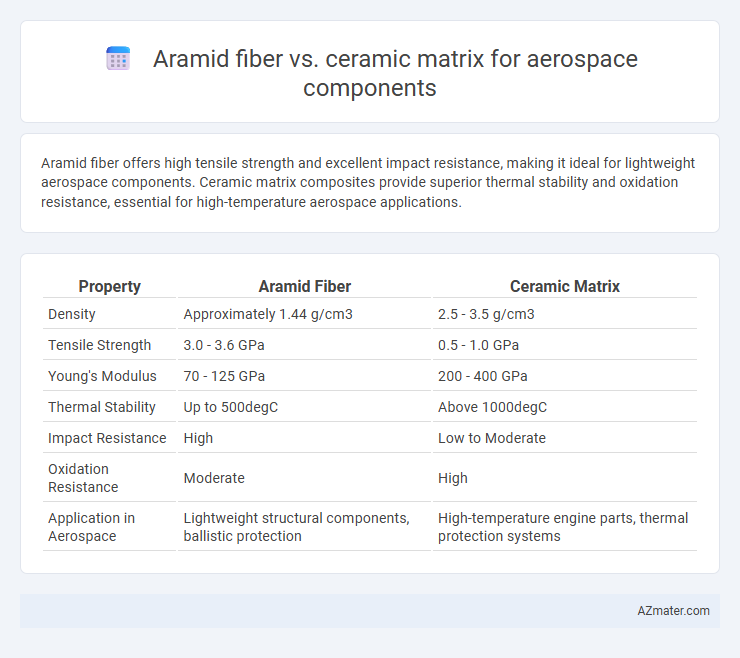Aramid fiber offers high tensile strength and excellent impact resistance, making it ideal for lightweight aerospace components. Ceramic matrix composites provide superior thermal stability and oxidation resistance, essential for high-temperature aerospace applications.
Table of Comparison
| Property | Aramid Fiber | Ceramic Matrix |
|---|---|---|
| Density | Approximately 1.44 g/cm3 | 2.5 - 3.5 g/cm3 |
| Tensile Strength | 3.0 - 3.6 GPa | 0.5 - 1.0 GPa |
| Young's Modulus | 70 - 125 GPa | 200 - 400 GPa |
| Thermal Stability | Up to 500degC | Above 1000degC |
| Impact Resistance | High | Low to Moderate |
| Oxidation Resistance | Moderate | High |
| Application in Aerospace | Lightweight structural components, ballistic protection | High-temperature engine parts, thermal protection systems |
Introduction to Aerospace Component Materials
Aramid fiber and ceramic matrix materials serve distinct roles in aerospace component design due to their unique properties. Aramid fibers offer exceptional tensile strength, lightweight characteristics, and impact resistance, making them ideal for composite structures requiring flexibility and damage tolerance. Ceramic matrix composites provide superior high-temperature stability and oxidation resistance, essential for components exposed to extreme thermal environments such as turbine blades and heat shields.
Overview of Aramid Fiber Properties
Aramid fiber exhibits exceptional tensile strength, high impact resistance, and excellent thermal stability, making it ideal for aerospace components requiring lightweight durability and heat tolerance. Its low density and exceptional fatigue resistance contribute to enhanced fuel efficiency and prolonged service life in aerospace structures. The fiber's ability to maintain structural integrity under extreme mechanical stress and temperature variations distinguishes it from ceramic matrix materials, which offer higher hardness but lack comparable toughness and flexibility.
Key Characteristics of Ceramic Matrix Composites
Ceramic Matrix Composites (CMCs) offer exceptional high-temperature resistance, superior oxidation and corrosion stability, and outstanding mechanical strength-to-weight ratios critical for aerospace components operating in extreme environments. Unlike Aramid fibers, which provide excellent toughness and impact resistance but have limited thermal stability, CMCs maintain structural integrity above 1200degC and exhibit low density, enhancing fuel efficiency and performance. The inherent brittleness of ceramics is mitigated in CMCs through fiber reinforcement, resulting in improved fracture toughness and thermal shock resistance essential for turbine engines and hypersonic vehicle applications.
Strength-to-Weight Ratio Comparison
Aramid fiber exhibits a high strength-to-weight ratio, making it ideal for aerospace components requiring flexibility and impact resistance. Ceramic matrix composites, while heavier, offer superior thermal stability and strength at elevated temperatures, critical for high-performance aerospace applications. The choice depends on balancing weight efficiency with operational temperature resistance, where aramid fibers excel in lightweight structures and ceramic matrices provide durability under extreme heat.
Thermal Resistance in Aerospace Environments
Aramid fiber exhibits excellent thermal resistance up to approximately 500degC, making it suitable for aerospace components exposed to moderate heat. Ceramic matrix composites (CMCs) withstand significantly higher temperatures, often exceeding 1,200degC, offering superior performance in extreme thermal environments like turbine engines and hypersonic vehicles. The distinct thermal stability of ceramic matrices ensures enhanced durability and structural integrity where aramid fibers would degrade under high-temperature aerospace conditions.
Impact Resistance: Aramid vs Ceramic Matrix
Aramid fibers exhibit superior impact resistance due to their high toughness and energy absorption capabilities, making them ideal for aerospace components subjected to dynamic loads and debris impact. Ceramic matrix composites, while offering excellent thermal stability and hardness, tend to be more brittle, leading to lower impact resistance under sudden shocks. Selection between aramid fiber and ceramic matrix hinges on balancing impact resilience with thermal and structural demands in aerospace applications.
Fatigue and Durability Performance
Aramid fiber composites exhibit exceptional toughness and high fatigue resistance, making them suitable for aerospace components subjected to repetitive loading and impact stresses. Ceramic matrix composites (CMCs) offer superior thermal stability and resistance to wear but typically have lower fatigue durability due to brittle fracture behavior under cyclic stresses. Combining aramid fibers with ceramic matrices can optimize fatigue performance by leveraging aramid's crack-bridging capabilities and ceramics' high-temperature durability in aerospace applications.
Cost and Manufacturing Considerations
Aramid fibers offer lower material and fabrication costs compared to ceramic matrix composites, making them more suitable for cost-sensitive aerospace components. The manufacturing process for aramid fiber composites involves simpler molding and curing techniques, resulting in faster production cycles and reduced labor expenses. Ceramic matrix composites require high-temperature processing and specialized equipment, increasing both manufacturing complexity and overall cost despite their superior thermal resistance.
Applications in Modern Aerospace Engineering
Aramid fiber composites offer exceptional impact resistance and lightweight strength, making them ideal for aerospace components such as helicopter rotor blades and protective cockpit armor. Ceramic matrix composites excel in high-temperature environments, providing superior thermal resistance and structural integrity for engine components and thermal protection systems. Both materials play crucial roles in advancing modern aerospace engineering by optimizing performance through tailored applications in structural and thermal management.
Future Trends in Aerospace Composite Materials
Aramid fibers offer exceptional toughness and impact resistance, making them ideal for aerospace components requiring lightweight durability, while ceramic matrix composites (CMCs) provide superior thermal stability and oxidation resistance for high-temperature applications like turbine engines. Future trends in aerospace composite materials emphasize hybrid composites combining aramid fibers and CMCs to achieve optimized strength-to-weight ratios and enhanced thermal protection. Innovations in nano-engineered interfaces and advanced manufacturing techniques, such as additive manufacturing and automated fiber placement, will drive the development of next-generation aerospace composites with improved performance and sustainability.

Infographic: Aramid fiber vs Ceramic matrix for Aerospace component
 azmater.com
azmater.com